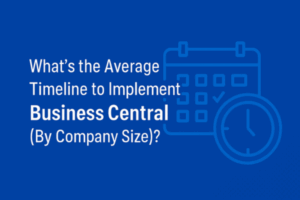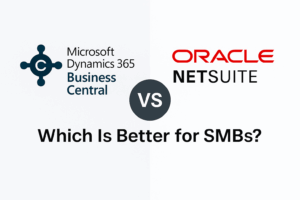Introduction: The Role of ERP in Distribution
Enterprise Resource Planning (ERP) systems play a vital role in the distribution industry, revolutionizing the way businesses manage their operations and streamline their processes. In this section, we will explore the key role that ERP systems play in distribution businesses and how they contribute to their success.
The Need for Efficient Operations
In the distribution sector, efficient operations are essential to meet customer demands, maintain optimal inventory levels, and ensure timely order processing and delivery. However, traditional manual systems and disparate software solutions often lead to inefficiencies, errors, and delays. This is where ERP comes in as a comprehensive solution that integrates various key functions and processes into a unified system.
Centralized Information and Real-time Visibility
One of the core benefits of ERP in distribution is the centralization of information. ERP systems provide a single database that consolidates data from different departments and functions, including inventory management, order processing, customer relationship management, and financials. This centralized data repository enables real-time visibility, allowing businesses to access accurate and up-to-date information for informed decision-making.
Streamlining Supply Chain Management
Effective supply chain management is crucial in the distribution industry. ERP systems provide features specifically designed to optimize supply chain processes, such as demand forecasting, procurement, warehouse management, and logistics. By integrating these functions into a cohesive system, ERP enables businesses to streamline their supply chain, improve inventory management, and enhance overall operational efficiency.
Automating Order Processing
Order processing is a critical aspect of distribution businesses. ERP systems automate and streamline the entire order processing cycle, from order entry to fulfillment and invoicing. This automation eliminates manual errors, reduces processing time, and improves order accuracy. Additionally, ERP systems often offer features like order tracking and alerts, enabling businesses to provide better customer service and enhance satisfaction.
Enhancing Customer Relationship Management
Maintaining strong customer relationships is vital for distribution businesses. ERP systems include customer relationship management (CRM) functionality, which enables businesses to manage customer interactions, track sales opportunities, and provide personalized service. With a centralized CRM system, businesses can better understand customer preferences, streamline communication, and foster long-term customer loyalty.
Optimizing Financial Management
Efficient financial management is key to the success of any distribution business. ERP systems provide robust financial modules that automate accounting processes, manage payables and receivables, track financial performance, and generate accurate financial reports. By integrating financial management into the ERP system, businesses can improve financial visibility, control costs, and ensure compliance with regulations.
In summary, ERP systems play a crucial role in the distribution industry by streamlining operations, providing real-time visibility, optimizing supply chain management, automating order processing, enhancing customer relationship management, and optimizing financial management. The next sections will delve deeper into the key features, benefits, and considerations of implementing ERP in distribution businesses.
Key Features of ERP Systems for Distribution
In this section, we will explore the key features of ERP systems that are specifically designed to cater to the needs of distribution businesses. These features are essential for optimizing operations, enhancing efficiency, and improving overall performance in the distribution industry.
Inventory Management
Inventory management is a critical aspect of distribution businesses. ERP systems provide robust inventory management functionality, allowing businesses to accurately track and manage their inventory levels. Key features include:
- Real-time inventory tracking: ERP systems enable businesses to track inventory levels in real-time, providing accurate visibility into stock availability, location, and movement.
- Demand forecasting: ERP systems utilize historical data and trends to forecast future demand, enabling businesses to optimize inventory levels and avoid stockouts or overstock situations.
- Warehouse management: ERP systems offer features for managing warehouse operations, including bin location tracking, barcode scanning, and automated replenishment processes.
Order Processing
Efficient order processing is essential for smooth operations in the distribution industry. ERP systems streamline the entire order processing cycle, from order entry to fulfillment. Key features include:
- Order entry and management: ERP systems provide a centralized platform for entering, managing, and tracking customer orders.
- Order fulfillment and shipping: ERP systems automate the process of order fulfillment, including picking, packing, and shipping. Integration with shipping carriers allows for seamless shipping label generation and tracking.
- Order status tracking: ERP systems enable businesses and customers to track the status of orders in real-time, providing transparency and improving customer satisfaction.
Customer Relationship Management (CRM)
Strong customer relationships are crucial for distribution businesses. ERP systems incorporate CRM functionality to manage customer interactions, track sales opportunities, and provide personalized service. Key features include:
- Customer database management: ERP systems maintain a centralized customer database, storing essential information such as contact details, purchase history, and preferences.
- Sales and lead management: ERP systems track sales activities, manage leads, and facilitate effective communication with customers and prospects.
- Customer service and support: ERP systems integrate customer service functionalities, such as ticketing systems, to ensure prompt and efficient response to customer inquiries and issues.
Supply Chain Management
Optimizing supply chain management is vital for distribution businesses to ensure smooth operations. ERP systems offer features specifically designed to streamline supply chain processes. Key features include:
- Demand planning and forecasting: ERP systems utilize historical data and demand patterns to forecast future demand, enabling businesses to optimize procurement and production planning.
- Procurement and vendor management: ERP systems automate procurement processes, including supplier selection, purchase order creation, and vendor performance tracking.
- Logistics and warehouse management: ERP systems optimize warehouse operations, including inventory replenishment, picking, packing, and shipping, to ensure efficient logistics management.
Financial Management
Efficient financial management is crucial for the success of any distribution business. ERP systems provide comprehensive financial management modules that automate accounting processes, track financial performance, and generate accurate financial reports. Key features include:
- Accounts payable and receivable: ERP systems automate the management of payables and receivables, including invoice processing, payment tracking, and collections management.
- General ledger and financial reporting: ERP systems maintain a centralized general ledger, enabling businesses to track financial transactions and generate accurate financial reports.
- Budgeting and forecasting: ERP systems facilitate budgeting and forecasting processes, allowing businesses to set financial goals, monitor performance, and make informed financial decisions.
In summary, ERP systems for distribution businesses offer key features such as inventory management, order processing, customer relationship management, supply chain management, and financial management. These features are essential for optimizing operations, enhancing efficiency, and improving overall performance in the distribution industry.
Benefits of Implementing ERP in Distribution
Implementing an ERP system in distribution businesses can bring a multitude of benefits. In this section, we will explore the various advantages that organizations can experience by adopting ERP for their distribution operations. These benefits extend beyond improving operational efficiency and can positively impact customer satisfaction, data analysis capabilities, and overall business performance.
Streamlined Operations
One of the primary benefits of implementing ERP in distribution is streamlining operations. By integrating various business functions and processes into a centralized system, ERP eliminates manual and disjointed processes, reducing errors and improving overall efficiency. Key benefits include:
- Elimination of duplicate data entry: With ERP, data only needs to be entered once, reducing the risk of errors and saving time.
- Automated workflows: ERP systems automate workflows, ensuring tasks are routed to the appropriate departments or individuals, reducing bottlenecks and delays.
- Standardized processes: ERP promotes standardization by enforcing predefined processes, ensuring consistency and reducing variations in operations.
Improved Customer Service
ERP systems enable distribution businesses to enhance their customer service capabilities, leading to improved customer satisfaction and loyalty. Key benefits include:
- Accurate and timely order processing: ERP streamlines the order processing cycle, reducing errors and ensuring faster order fulfillment.
- Real-time order tracking: ERP provides customers with real-time visibility into the status of their orders, improving transparency and communication.
- Personalized customer interactions: ERP’s integrated CRM functionality allows businesses to better understand customer preferences and provide personalized service.
Enhanced Data Analysis
ERP systems provide robust reporting and analytics capabilities, enabling distribution businesses to extract valuable insights from their data. Key benefits include:
- Real-time data access: ERP systems provide real-time access to accurate and up-to-date data, allowing businesses to make informed decisions.
- Data-driven decision-making: ERP’s reporting and analytics tools help businesses analyze trends, identify opportunities, and make data-driven decisions.
- Performance monitoring: ERP systems allow businesses to track key performance indicators (KPIs) and monitor their performance against goals, facilitating continuous improvement.
Increased Efficiency and Productivity
Implementing ERP in distribution can significantly boost efficiency and productivity within the organization. Key benefits include:
- Streamlined processes: ERP eliminates manual and redundant tasks, allowing employees to focus on value-added activities.
- Automated workflows: ERP automates routine tasks, reducing manual intervention and freeing up time for more strategic work.
- Resource optimization: ERP’s centralized system enables better resource allocation and utilization, maximizing efficiency.
Reduced Operational Costs
ERP systems can lead to cost savings for distribution businesses in various ways. Key benefits include:
- Elimination of manual processes: ERP automates manual tasks, reducing the need for labor-intensive processes and associated costs.
- Inventory optimization: ERP’s advanced inventory management capabilities help minimize stockouts and overstock situations, reducing carrying costs.
- Improved financial management: ERP’s financial modules streamline accounting processes, reducing administrative costs and improving financial visibility.
In summary, implementing ERP in distribution businesses brings several benefits, including streamlined operations, improved customer service, enhanced data analysis capabilities, increased efficiency and productivity, and reduced operational costs. These benefits contribute to improved business performance, customer satisfaction, and overall competitiveness in the distribution industry.
Choosing the Right ERP for Your Distribution Business
Choosing the right ERP system for your distribution business is a crucial decision that can impact your operations and overall success. In this section, we will discuss key considerations and steps to follow when selecting an ERP solution that aligns with your business needs and requirements.
Understanding Your Business Needs
Before embarking on the ERP selection process, it is essential to have a clear understanding of your business needs and requirements. Consider the following factors:
- Business processes: Identify the specific processes and functions that you want the ERP system to support, such as inventory management, order processing, CRM, and financial management.
- Scalability: Assess your future growth plans and ensure that the chosen ERP system can scale accordingly to accommodate increased operational demands.
- Integration requirements: Determine the systems or applications that need to be integrated with the ERP system, such as e-commerce platforms, third-party logistics providers, or other business software.
- Budget: Define your budget for ERP implementation, including upfront costs, ongoing maintenance, and support fees.
Evaluating Different ERP Vendors
Once you have a clear understanding of your business needs, it’s time to evaluate different ERP vendors. Consider the following factors during the evaluation process:
- Vendor reputation and experience: Research and evaluate the reputation, experience, and industry expertise of potential ERP vendors. Look for vendors that have a proven track record of successful implementations in the distribution industry.
- ERP system functionality: Assess the functionality and features offered by each ERP system. Ensure that the system aligns with your specific business needs and requirements.
- Customization and flexibility: Determine the level of customization and flexibility offered by each ERP system. It’s important to choose a solution that can be tailored to your unique business processes.
- User-friendliness: Consider the ease of use and user interface of the ERP system. A user-friendly system will minimize training time and ensure smooth adoption by your employees.
- Mobile capabilities: Evaluate whether the ERP system offers mobile access and capabilities, allowing your team to access critical information and perform tasks on-the-go.
Cost and ROI Considerations
The cost of implementing an ERP system can vary significantly. Consider the following cost factors and calculate the return on investment (ROI) for each potential ERP solution:
- License fees: Understand the upfront license fees associated with the ERP system, including any additional costs for user licenses or modules.
- Implementation costs: Consider the costs associated with implementing the ERP system, such as data migration, system configuration, and employee training.
- Ongoing maintenance and support fees: Determine the ongoing costs for system maintenance, updates, and technical support.
- ROI analysis: Calculate the potential ROI for each ERP system by comparing the expected benefits, such as increased efficiency, cost savings, and improved customer satisfaction, with the associated costs.
Implementation Process and Support
The implementation process and support provided by the ERP vendor are crucial factors to consider. Evaluate the following:
- Implementation timeline: Understand the estimated timeline for implementing the ERP system and ensure it aligns with your business goals and objectives.
- Implementation methodology: Assess the vendor’s implementation methodology and determine if it aligns with your organization’s project management approach.
- Training and support: Evaluate the training and support services offered by the ERP vendor. Ensure that they provide comprehensive training for your employees and ongoing technical support after the implementation.
Vendor References and Case Studies
Request vendor references and case studies from potential ERP vendors. Contact existing customers and ask for their feedback and experiences with the system and vendor. This will provide valuable insights into the vendor’s reliability, customer service, and the effectiveness of their ERP solution in the distribution industry.
In summary, choosing the right ERP system for your distribution business requires a thorough understanding of your business needs, evaluation of different vendors, consideration of cost and ROI, assessment of implementation processes and support, and review of vendor references and case studies. Taking these steps will help ensure that you select an ERP solution that aligns with your business requirements and sets your distribution business up for success.
Conclusion: The Future of ERP in Distribution
In conclusion, Enterprise Resource Planning (ERP) systems have become an essential tool for distribution businesses, revolutionizing the way they manage their operations, streamline processes, and improve overall efficiency. The key features and benefits of ERP systems discussed in this blog post highlight the significant impact that ERP can have on distribution businesses.
By implementing ERP, distribution businesses can streamline their operations, improve customer service, enhance data analysis capabilities, increase efficiency and productivity, and reduce operational costs. These benefits directly contribute to improved business performance, customer satisfaction, and overall competitiveness in the distribution industry.
Looking ahead, the future of ERP in distribution is promising. Advancements in technology, such as cloud-based ERP solutions, mobile capabilities, and integration with emerging technologies like artificial intelligence (AI) and the Internet of Things (IoT), will further enhance the capabilities and functionalities of ERP systems for distribution businesses.
Cloud-based ERP solutions offer scalability, flexibility, and cost-effectiveness, allowing businesses of all sizes to adopt ERP without significant upfront investments. The ability to access ERP systems on mobile devices enables real-time data access and facilitates remote work, providing greater flexibility and agility in distribution operations.
Integration with AI and IoT technologies opens up new possibilities for automation, predictive analytics, and improved supply chain management. ERP systems can leverage AI to analyze data and provide intelligent insights for better decision-making. IoT integration allows for real-time monitoring of inventory, assets, and equipment, optimizing operational efficiency and enabling proactive maintenance.
To fully leverage the future potential of ERP in distribution, businesses should stay updated on emerging trends, invest in ongoing training and support for employees, and continuously evaluate and optimize their ERP systems to align with evolving business needs.
In conclusion, ERP systems have transformed distribution businesses by streamlining operations, enhancing customer service, improving data analysis capabilities, boosting efficiency and productivity, and reducing costs. With advancements in technology, the future of ERP in distribution looks promising, offering even greater opportunities for businesses to thrive in an increasingly competitive landscape. By embracing the power of ERP, distribution businesses can position themselves for long-term success and remain at the forefront of the industry.


















